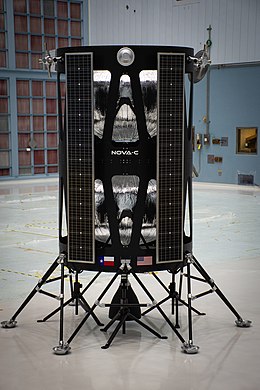Intuitive Machines Nova-C
 Nova-C model | |
| Designer | Intuitive Machines |
|---|---|
| Country of origin | US |
| Applications | Lunar payloads delivery |
| Specifications | |
| Spacecraft type | Lander |
| Dry mass | 1,500 kg (3,300 lb) [1] |
| Payload capacity | 100 kg (220 lb) [2] |
| Power | 200 W (0.27 hp)[2] |
| Dimensions | |
| Length | 3 m (9.8 ft)[1] |
| Diameter | 2 m (6 ft 7 in)[1] |
| Production | |
| Status | in development |
| Launched | 0 |
| Maiden launch | 11 October 2021 (planned)[3] |
| Related spacecraft | |
| Derived from | Project Morpheus[2] |
Nova-C is a lunar lander designed by the private company Intuitive Machines to deliver small commercial payloads to the surface of the Moon.
Intuitive Machines was one of the 9 contractor companies selected by NASA in November 2018,[4] and Nova-C is one of the first three landers selected to be built and launched by the new NASA program called Commercial Lunar Payload Services. Launch is planned on a Falcon 9 rocket on 11 October 2021.[3][2][5]
Overview
Nova-C lunar lander was designed by Intuitive Machines, and it inherits technology developed by NASA's Project Morpheus.[2] It features a spacecraft propellant system that uses methane and liquid oxygen, and an autonomous landing and hazard detection technology. After landing, the lander is capable of relocating by performing a vertical takeoff, cruise, and vertical landing.[2] Methane and oxygen could also be potentially manufactured on the Moon and Mars.[6][7] (See: In-situ resource utilization.) Nova-C is capable of 24/7 data coverage for its client payload, and can hold a payload of 100 kg.[2] The Nova-C lander design provides a technology platform that scales to mid and large lander classes, capable of accommodating larger payloads.[8]
First flight
Nova-C was selected in May 2019 for NASA's CLPS as one of the first three landers of this program, that is tasked with delivering small payloads to explore and test technologies to process some natural resources of the Moon. NASA awarded Intuitive Machines $77 million for building and launching Nova-C.[8] The other selected lander is the Peregrine by Astrobotic.[9]
For its first flight, planned for October 2021,[3] Nova-C will carry up to five NASA-sponsored instruments to land at Oceanus Procellarum.[10] In addition, the lander will also carry some payloads from other customers.[5] The lander will operate for one lunar day, which is equivalent to about 14 Earth days.[5]
See also
- Current lunar lander programs
- Chandrayaan Programme, by India
- Chinese Lunar Exploration Program
- Luna-Glob, by Russia
References
- ^ a b c Houston company among 9 tapped to build moon landers Archived 2018-12-01 at the Wayback Machine. Alex Stuckey, The Houston Chronicle. 30 November 2018.
- ^ a b c d e f g Nova-C Lunar Lander. Home site. Intuitive Machines. Accessed on 28 May 2019.
- ^ a b c Kanayama, Lee (13 April 2020). "NOVA-C selects landing site, Masten gains CLPS contracts". NASASpaceFlight. Retrieved 3 May 2020.
- ^ "NASA Announces New Partnerships for Commercial Lunar Payload Delivery Services". NASA.GOV. NASA. Retrieved November 29, 2018.
- ^ a b c [1] Mike Wall, Space.com. 2 October 2019.
- ^ "Innovative Partnership Tests Fuels of the Future". NASA. October 13, 2009. Retrieved March 3, 2012.
- ^ Nasa's new Mars landing craft Morpheus bursts into flames on take-off. The Telegraph 10 August 2012.
- ^ a b Intuitive Machines Headed To The Moon In 2021 Archived 2019-06-02 at the Wayback Machine. Space Mining News. 30 November 2018.
- ^ NASA funds commercial moon landers for science, exploration. Astronomy Now. 2 June 2018.
- ^ NASA picks three companies to send commercial landers to the moon. Stephen Clark, Spaceflight Now. 4 June 2019.

